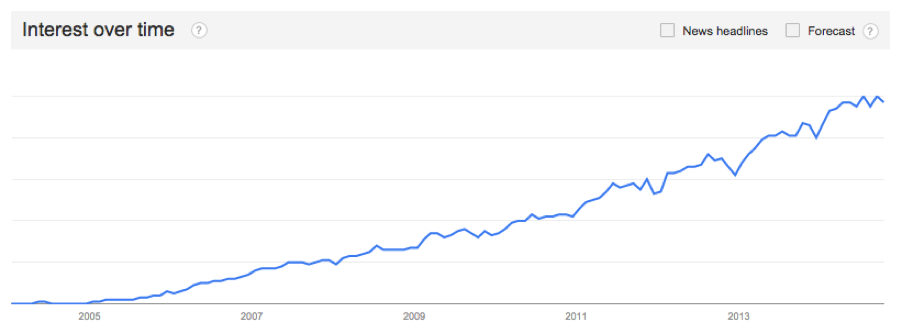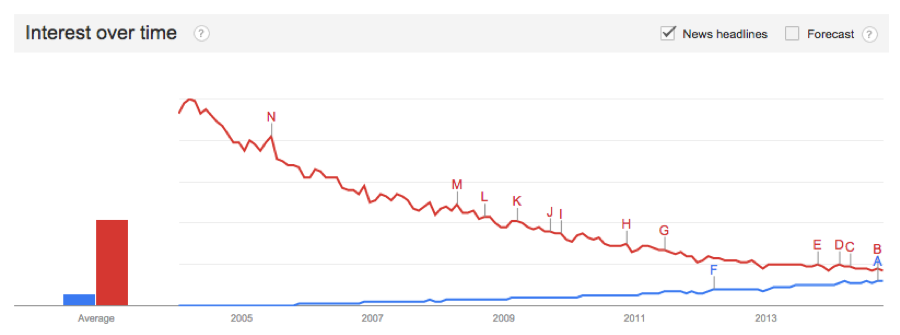Last updated at Fri, 03 Nov 2017 19:20:28 GMT
Some days it’s hard to remember if Moore’s law applies to increasing computer power or the number of technologies and breadth of terminology impacting our daily work.
JSON, short for JavaScript Object Notation, continues to gain momentum in our increasingly connected world. Reading this primer will give you a baseline understanding so you can start having intelligent conversations about the pros and cons of using JSON with your team.

What is JSON?
Contrary to its naming convention, JSON is a language-independent data exchange format that enables us to quickly and easily share information between all of our systems and devices, regardless of technology. In the subsequent sections we will dive into why JSON has been increasing in popularity and usage recently.
To illustrate the rise of JSON, check out the trend graph below, which shows a steady increase in the amount Google searches for JSON over the last 10 years.

What’s the difference between JSON & XML
To really understand this increase, let’s compare the search volume for JSON (blue) against the search volume for XML (red). XML is currently the most used data exchange format, but we can see that if the current trend continues there will be more people trying to learn about what JSON is than XML in the next year or two.
 What is responsible for the JSON revolution?
What is responsible for the JSON revolution?
Why are people moving away from a legacy technology like XML into a new domain?
There are a couple major driving factors from both the human and machine side; the first is ease of use. Below is an example data set representing the contact details for a person in both JSON and XML.
Example JSON Code
{“FirstName”: “John”,
“LastName”: “Smith”,
“Age”: “27,
“Address”: {
“StreetNumber”: 34,
“StreetName”: “Farnsworth”,
“City”: “Boston”,
“State”: “MA”,
“PostalCode”: “02210”,
“Country”: “USA”
},
“ContactDetails”: {
“PhoneNumber”: “555 555 5555”,
“Email”: {
“Type”: “Work”,
“EmailAddress”: “John.Doe@Logentries.com”
}
}
}
Example XML Code
<Person>
<FirstName>John</FirstName>
<LastName> Doe</LastName>
<Age>27</Age>
<Address>
<StreetNumber>34</StreetNumber>
<StreetName>Farnsworth</StreetName>
<City>Boston</City>
<State>MA</State>
<PostalCode>02210</PostalCode>
<Country>USA</Country>
</Address>
<ContactDetails>
<PhoneNumber>555 555 5555</PhoneNumber>
<Email>
<Type>Work</Type>
<EmailAddress>John.Doe@Logentries.com</EmailAddress>
</Email>
</ContactDetails>
</Person>
Readability
XML and JSON are both excellent examples of human readable languages. Human readability is paramount to effectively working with unstructured data. It allows your teams to quickly understand what data is available enabling them to provide the reporting and insight you require to effectively run your business.
Key-value pairs (KVPs) are another major improvement found in JSON compared to XML. KVPs are perfectly suited to the unstructured data found in today’s big data environments. The explicit relationship defined in the KVP format enables advanced analytic solutions to automatically identify, highlight and query against the values stored without any additional coding or configuration even as the data you are tracking changes.
What is JSON’s role in the rise of big data?
Another major consideration is the rise of big data. The massive amount of data being transmitted by corporations today requires a lightweight data exchange language. In the examples above, the JSON code contains 355 characters while the XML code contains 461.
While at first glance this might not seem like a huge difference, it actually accounts for a 30% increase in data sent in the XML example.
With corporations operating big data solutions that can process Terabytes to Petabytes of data everyday it is easy to understand that the additional overhead present in XML can lead to additional costs, network congestion and latency to critical operations.
JSON for the win!
To effectively manage and analyze data in a world of increasing quantities of unstructured data, people are looking towards KVP formats to provide the flexibility, speed and functionality they require. This has led to a steady increase in the usage of JSON to share data between the applications and devices that make our world run.
When you combine these features with intuitive analytic tools, such as Logentries, you enable a larger part of your organization to benefit from the data you currently store and track. We are now able to move away from the legacy approach where data scientists and implementation teams spend months trying to figure out the perfect metrics based on historical decision points. Winning companies in today’s world adapt to new trends quickly by enabling their teams to access the right data at the right time.
Now that you better understand what JSON is, you’re ready to work with JSON in Logentries. Start a free 30-day trial of Logentries today and check out JSON for yourself.

